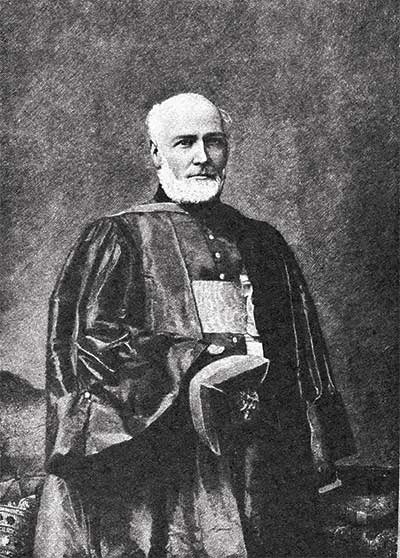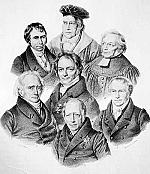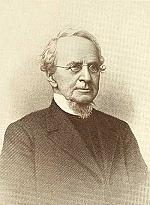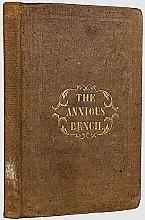“An undivided kingdom of God”

[Philip Schaff in St Andrews, Scotland, in Literature and Poetry by Philip Schaff, 1890—Public domain, Internet Archive]
Early in the year 1818, Anna Luisa Schindler abandoned her husband and escaped to the tiny Swiss village of Chur, located near the source of the Rhine River. There she met a local carpenter of limited means called Philipp Schaf. On the first day of the new year, she gave birth to their son, also named “Philipp Schaf.” But Schindler’s past haunted her new life. Soon after Philipp’s baptism on Epiphany Sunday in the local Reformed parish, authorities expelled her from the village for bearing the child out of wedlock and for breaching her prior marriage contract. Within a year the boy’s father died. The orphaned infant became a ward of the state. He only came to know his mother in later life; he never knew his father at all.
In his reminiscences Philip Schaff (who only permanently changed the spelling of his name in the 1840s) did not elaborate on the particulars of his humble origins. Indeed he may have been entirely unaware of some of these details. He did, however, credit his upbringing in poverty and obscurity as key to the development of his character, industry, and self-reliance.
AGONIZED PRAYER, NEW BIRTH
Young Schaff’s intellectual abilities were recognized early on. A scholarship enabled the teenager to complete secondary school and enter the Kornthal Academy for boys in the Württemberg region of Germany. As an independent institution modeled after the schools associated with the Moravian Brethren, Kornthal advanced the values of rigorous academic training, personal piety, and a commitment to the general welfare (find more on the Moravians in CH #1). In this virtuous atmosphere, Schaff found himself one morning in a forest at prayer, crying in intense agony; suddenly he experienced a “new birth” and dedicated himself thenceforth to the “service of God.”
During his sixteenth year, Schaff was confirmed on Easter Sunday in the Lutheran church at Kornthal. His brief stay at the academy was followed by a much longer period of study at the Gymnasium (high school) in nearby Stuttgart. There Schaff lodged with the family of Johann Georg Mann, a prominent merchant whose son, William Julius Mann (1819–1892), became a lifelong friend.
IN GOOD COMPANY
Schaff began his theological studies at Tübingen University in 1837. Unusual for the time, the university included both Protestant and Catholic faculties of theology. Schaff was particularly influenced by Isaak August Dorner (1809–1884), who taught that theologians must first possess the immediate certainty of faith, and then they could pursue the scientific explication of what faith believes. With his focus on the centrality of the human being’s union with God, Dorner concluded that God’s primary attribute, as exemplified in Christ, is love.
From Tübingen Schaff traveled to the University of Halle where he lived in the home of Professor Friedrich August Gottreu Tholuck (1799–1877). Schaff served as Tholuck’s personal secretary, and he dined regularly in the Tholuck home around a table that often included visiting colleagues from Berlin and elsewhere. Schaff then moved on to the University of Berlin to complete his theological studies. He worked closely with church historian Johann August Wilhelm Neander, whom he came to regard as his most significant mentor.
Neander, like Schaff, had endured hardship and poverty in his childhood. Born in Göttingen with the name David Mendell, he converted from Judaism to Christianity at the age of 17, inventing for himself the name “Neander,” that is “new man” (see pp. 38–41). Neander was intensely Christocentric and interpreted all theological themes in the light of the Incarnation and the believer’s living union with Christ. His theological convictions about the nature of the church and his approach to writing about the church inspired Schaff to pursue church history.
This august company of scholars all identified themselves in one way or another as proponents of the “mediating theology”—a movement that developed under the influence of both Schleiermacher and Hegel. Characteristic of Schleiermacher’s idea of mediation was that mediators arise from time to time who pronounce God’s will in a way that joins disparate viewpoints and factions into a new unity. One practical consequence of Schleiermacher’s position was his endorsement of the Evangelical United Church in Prussia: a union of Reformed and Lutheran churches throughout the Prussian Empire brought about in 1817 by King Frederick Wilhelm III.
Schleiermacher composed his famous volume of systematic theology, The Christian Faith (1822), with special reference to the union of the two Protestant churches. Hegel, meanwhile, espoused the theory that history advances in a dialectical pattern. History, from his point of view, moved by way of thesis and antithesis to a synthesis after competing or conflicting elements were cast off or discarded, resulting in a new beginning. These ideas were foundational for Schaff during his university studies, which concluded in 1841 when he received the degree of licentiate in theology from the University of Berlin.
KISSING THE RED SLIPPER
Shortly thereafter Schaff embarked upon a 14-month sojourn through Switzerland and Italy as a tutor to a baron’s son. The party went to Rome, where 22-year-old Schaff preached the Palm Sunday sermon in the city’s Protestant chapel before Prussian princes. After Easter Schaff and his fellow travelers received an audience at the Vatican with Pope Gregory XVI (reigned 1831–1846). He recorded in his diary discomfort with kissing the pontiff’s red slippers. From Rome the party ventured to Turin, where they were hosted by the Waldensians, a religious community deemed heretical by the Catholic Church (read more about the Waldensians in CH #22).
When Schaff returned to Berlin, he assumed the role of Privatdozent, or “independent lecturer,” at the university. His close associations in academic and ecclesiastical circles led to a meeting with two emissaries from the German Reformed Church in America and ultimately the unanimous election of Schaff to the chair of church history and biblical literature at the theological seminary at Mercersburg, Pennsylvania. The church synod extended a call to Schaff on October 19, 1843, signed by the synod’s president, Joseph Berg (1812–1871). But in less than a year, Berg would become Schaff’s chief antagonist in the German Reformed Church.
On April 12, 1844, Schaff’s ordination service took place in Elberfeld, Germany, under the Pastor’s Aid Society, a missionary society that assisted immigrants to America. Thus Schaff, who had been baptized in the Swiss Reformed Church and confirmed in the Lutheran Church, was ordained by the Evangelical United Church. Schaff’s religious career reflected a process of growth central to his thinking about the very nature of church history itself. In his ordination sermon, Schaff preached on the words of the Macedonian as recorded in the book of Acts: “Come over and help us!” (Acts 16:9). His sermon concluded with an eschatological vision of a united Christendom gathered into one triumphant throng and the suggestion that it was toward the actualization of such a universal church—“an undivided kingdom of God”—that he would labor in America.
“CHURCH OF THE ANTICHRIST”
At a gathering of the German Reformed Church Synod in Reading, Pennsylvania, on October 25, 1844, Schaff delivered in German his inaugural address on the “Principle of Protestantism.” His topic was not intended to be controversial; rather, he offered his address as a summary of the basic approach to the discipline of church history that he had been called to Mercersburg to teach. Still many elements of Schaff’s lecture were new and controversial in an American church context foreign to him.
In his address Schaff insisted upon maintaining the connection between Roman Catholicism and Protestantism because, despite numerous “aberrant” practices, Catholicism had brought Christianity forward in time to the point where reformation was both necessary and possible. Approaching his defense from a Hegelian perspective, Schaff explained that the relationship between Protestantism and Catholicism displayed Christianity’s dialectic movement through history, until ultimately the church would unite on the great day of Christ’s return. Like a river, Schaff argued, extremes on both sides diverted the course of the church and might even carry it backward for a time, but forward progress continued in the deep waters of the mainstream. Eventually, all the shallow waters languishing along opposing shores would return to the river’s flow.
Schaff located the reforming principle that gave birth to Protestantism in this mainstream and anticipated a Protestantism in America that would absorb the various Protestant sects and denominations as they served out their corrective purposes. He foresaw the inevitable convergence among the churches as a sign of the coming kingdom. And so Schaff’s address ended on a hopeful note. He looked forward to an emerging “evangelical catholicism” on the soil of the New World: a magnificent union that would complete in the nineteenth century the reformation that was begun in the sixteenth century.
Despite Schaff’s hopeful vision, his address clashed significantly with both the denomination’s position and the region’s cultural climate. Only a few months before Schaff’s arrival in Pennsylvania, anti-Catholic rioting had broken out in President Berg’s neighborhood in Philadelphia—a social tension affecting many American cities at that time. In addition, just one week before Schaff’s inaugural address, Berg himself had addressed the synod’s opening assembly, arguing that the German Reformed Church had maintained the purity and strength of the original apostolic church and that it received this heritage from protesting churches throughout history that were entirely uncontaminated by Roman influence. Their witness had culminated in the fourteenth century in the Waldensian community: the Waldensians were the true parent of the German Reformed Church in the United States, according to Berg. In this scheme a static Protestant orthodoxy that originated among the apostles served as the true Christian witness against the Roman Catholic Church, or what Berg called the “Church of the Antichrist.”
A starker contrast with Schaff is hardly imaginable. Berg convened a committee of the Philadelphia Classis in September 1845 to pursue charges of heresy against Schaff. The ensuing examination itself was anticlimactic: the Berg faction was completely dismissed. The Principle of Protestantism, by then translated into English by John Nevin, was declared by the Classis to promote the true interests of religion. Both Schaff and Nevin—who defended Schaff’s work tirelessly in articles in the denomination’s newspaper—were praised for their efforts to “build up and honor the welfare of the church.”
“IN ALL THINGS CHARITY”
With the unpleasantness of the heresy trial behind him, Schaff committed himself to life in America. Within a year of his arrival, he “married a Mary from Maryland” and settled into home life with Mary Elizabeth Schley. At the Mercersburg seminary he continued his defense of historical development with two key articles: “What Is Church History?” (1846) and “German Theology and the Church Question” (1852). In the larger context of interdenominational relations, Schaff pursued efforts to draw German and American churches into dialogue. He edited the journal Der Deutsche Kirchenfreund (1848–1853), which strove to publish the greatest scholarship from Germany for United, Lutheran, Moravian, and Reformed churches of German descent in America. The watchword for this publication was that of Lutheran theologian Rupertus Meledinius (1582–1651): “In essentials unity, in nonessentials liberty, in all things charity.”
When Schaff resigned from his editorial duties, his secondary school friend, William Julius Mann—subsequently professor at the Lutheran seminary in Philadelphia—took over responsibilities as editor. Schaff also lectured abroad about the state of religious affairs in America, resulting in the publication of his book America: A Sketch of the Political, Social, and Religious Character of the United States of North America (1855). And he wrote about events and people in Germany for an American audience, as in Germany: Its Universities, Theology and Religion (1857).
Philip Schaff was deeply committed to the worship life of the church and the devotional life of its members. He helped develop the German Reformed Church’s provisional liturgy of 1857, which reflected his Christocentric understanding of the church and affirmed its historical nature by including forms and phrases that extended across confessional lines and back to before the Reformation. He also produced a German hymnbook (1859) for use in the churches of various denominations and a Catechism for Sunday Schools and Families (1862).
The arrival of the Civil War at nearby Gettysburg precipitated the departure of Schaff and his family from the seminary to New York City beginning in 1863. In 1870 he became a professor at Union Theological Seminary and remained there for another 22 years. Although Schaff’s optimism about the future seemed boundless, it was tempered by a familiarity with grief. Of the eight children he and Mary raised, only three survived to adulthood. He addressed this grief in his privately circulated volume, In Memoriam: Our Children in Heaven (1876).
LAST WILL AND TESTAMENT
Schaff considered the writing of church history to be central to the idea of the church itself and essential for the church’s development. His three-volume work Creeds of Christendom (1877), his seven-volume History of the Christian Church (1882–1892), and his scholarly collection of Nicene and Post Nicene Fathers (1886–1890) are fruits of this conviction. As an ambassador for the church universal, he also established societies that still foster scholarly conversations and collaborations, such as the American Society of Church History and the Society of Biblical Literature. And remarkably for a non-native English speaker, he traveled between Great Britain and the United States as chair of the translation committee to revise the King James Version of the Bible.
Schaff delivered his final address—it could be called his last will and testament—in Chicago at the World’s Parliament of Religions in 1893. Entitled “The Reunion of Christendom,” the speech surveyed the religious landscape of the entire world, celebrated the progress of Christianity throughout the world, and envisioned in this development signs of the coming kingdom, to be achieved, or granted, perhaps, in the coming century. This providential vision of the church’s progress toward visible church union animated Schaff’s career and grounded the theological movement he and Nevin led: a movement breathed into being at Mercersburg. CH
By Theodore Louis Trost
[Christian History originally published this article in Christian History Issue #155 in 2025]
Theodore Louis Trost is professor in religious studies and New College at The University of Alabama.Next articles
Christian History timeline: the Mercersburg movement
Chronology of Mercersburg theological movement
Anne T. ThayerRevival, rightly understood?
John Williamson Nevin and “New Measures” revivalism
John Williamson NevinSupport us
Christian History Institute (CHI) is a non-profit Pennsylvania corporation founded in 1982. Your donations support the continuation of this ministry
Donate







